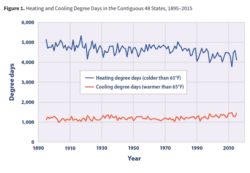This indicator examines changing temperatures from the perspective of heating and cooling needs for buildings.
This indicator uses daily temperature data from thousands of weather stations across the United States to calculate heating and cooling degree days. A “degree day” is determined by comparing the daily average outdoor temperature with a defined baseline temperature for indoor comfort (in this case, 65°F). For example, if the average temperature on a particular day is 78°F, then that day counts as 13 cooling degree days, as a building’s interior would need to be cooled by 13°F to reach 65°F. Conversely, if the average outdoor temperature is 34°F, then that day counts as 31 heating degree days, as a building’s interior would need to be warmed by 31°F to reach 65°F. This does not mean that all people will actually heat or cool buildings to 65°F; it is just a number to allow for consistent comparisons over time and across the country. For reference, New York City experiences far more heating degree days than cooling degree days per year—a reflection of the relatively cool climate in the Northeast—while Houston, Texas, has far more cooling degree days than heating degree days—a reflection of the much warmer climate in the South.2
Figure 1 shows each year’s average heating and cooling degree days across the contiguous 48 states. Figures 2 and 3 show how heating and cooling degree days have changed by state, based on a comparison of the first 60 years of available data (1895–1954) with the most recent 61 years (1955–2015). State and national averages were calculated by finding the total number of heating and cooling degree days per year at each weather station, averaging the results from all stations within regions called climate divisions (each state within the contiguous 48 has up to 10 climate divisions), then calculating state and national averages weighted by the population of each climate division. With this population-weighting approach, average state and national heating and cooling degree days more closely reflect the conditions that the average resident would experience.




